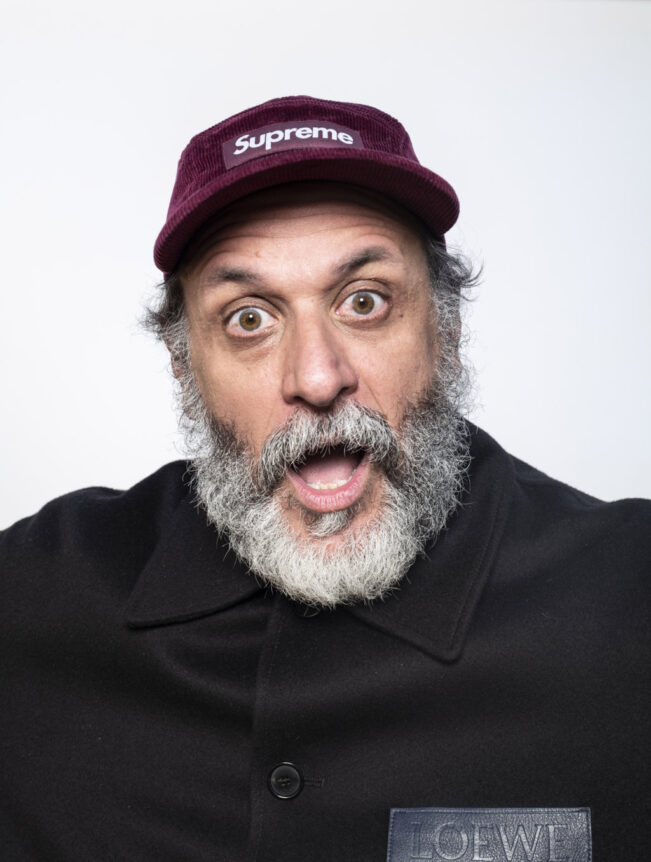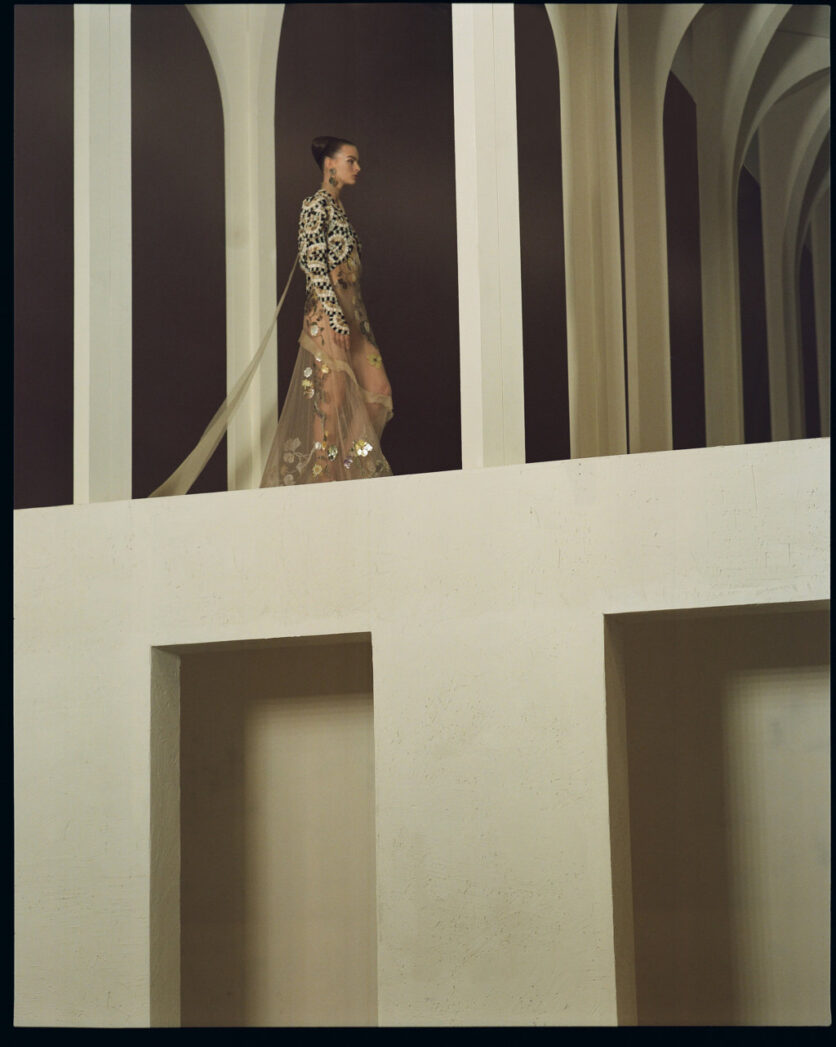The director Luca Guadagnino has been setting up and structuring an interior design studio for a few years now, actively working with a group of young, talented, professionals. Each project is a great choral effort, in which many instruments have to play happily together.
Last year, in the bombastic first post-pandemic Salone del Mobile, immersed in an unnatural atmosphere bordering on collective hysteria, I was told about an almost secret place, an unexpected room I was supposed to visit. I had no other information.
It was one of those sunny afternoons that declare spring and the street was flooded with a warm, almost blinding light. I approached the entrance and noticed the windows, completely darkened, of what I knew as an art gallery. At the door two well-dressed guys, as if entering a private club. I think of the usual salon exaggerations and unzip a heavy fabric to enter. I find myself plunged into another place, out of time, symmetrical and framed by two fireplaces looking at each other on the opposite side walls, framed by an elegant boiserie organised through a system of geometries rhythmic by wooden slats. Each fireplace was centred by a pair of wall lamps, while the ceiling and side walls were treated with slightly oblique walls of pleated fabric that increased the vertical compression of the space.
The symmetry was only superficially perfect: the two fireplaces were resolved differently materially, one in severe Ceppo di gré and the other in coloured ceramic; the two pairs of Fontanarte lamps were different and so were the geometries of the wooden walls. There was an obsessive, meticulous, cultured and pervasive thought that followed every detail, reinforcing the overall perception of this room. There was so much, refined, history of European interior architecture of the 1920s and 1930s, but the result was not nostalgic.
It was only at that point that I asked whose work it was and found out that the director Luca Guadagnino had, a few years ago, set up and structured an interior design studio that was actively working with a group of young, talented professionals.
For this reason and because of the curiosity that this discovery had aroused in us, Platform decided to dedicate the cover to him on the occasion of this new Salon, which we hope will be different, knowing that studiolucaguadagnino, for this year, has taken a break from the Milanese appointment.
And entering the complex and composite world of a studio that was born and is supervised by a great author, but which, at the same time, supports and dialogues with many designers and craftsmen, we decided that this time we would not do the traditional interview, but that I would write a critical text to give voice to all the souls of the studio and its work.
Encounters never happen by chance, but are the result of an intimate search or a profound intuition that suddenly takes shape through opportunities that facilitate choices we may have already made. And so the meeting between an important Italian entrepreneur, who wants to make a home but cannot find the right architect and solutions, and Luca Guadagnino, who was asked for advice and came out as a designer, illuminates a path that takes shape with impressive determination and lucidity. The studio started up in 2016 together with his friend architect and photographer Giulio Ghirardi, who had already worked with him on some of his films, and quickly structured itself into a real design studio in which, over the course of a few years, first Stefano Baisi and Eleonora Grigoletto and now Nicolò Rosmarini were integrated, together with a well-staffed team.
The initial residential project on which the studio was formed was followed by two shops for Aesop in Rome and London, another venue for Redemption in Soho/NY and a series of other environmental fashion installations between Rome and Venice.
Each work follows its own trajectory, a hand-in-hand with the location and a constant focus on the absolute quality of the project, which is imagined as a total work of art, arriving at the design of every single element and detail.
Each project has its own warmth and domesticity. The material used speaks with sincerity and the starting references, multiple and selected, are consciously mixed to the point of generating original artefacts and spaces but, at the same time, with the feeling of having been inhabited for a long time.
There is a desire not to be consumed and to resist a time that devours everything with little grace and care. In this, the details and places built with the best craftsmen become intimate faults of disturbance to the excess of images and emotions that overwhelm us daily, giving us spaces that are impertinent and graceful at the same time, that have the audacity to survive the present time.
The projects indicate a right time to decide and at the same time a strong vision, which imagines the actions and movements of different bodies and desires over time, making each place welcoming, but never predictable. The feeling one gets when looking at these works is that of the search for a physical and formal definition of classic that does not get worn out despite changing fashions and styles, because the quality we are offered and inhabit endures and envelops us with its non-aggressive personality. There is a sense of steadfastness in many of the details that indicate the strength of a vision without being arrogant: from the metal and leather handrails frequently used, to the star-studded marble floor by Aesop London that clashes with a monobloc of semi-gritty material encamped in the centre of this compressed space, from the wooden panelling that conceals discreet openings, to the always unique treatment of the walls.
Natural light plays a decisive role and is administered with naturalness and wisdom.
It is useless to search for a common language as much as, rather, each project is pervaded by a taste and that notion of Pontian style – and not only – that accompanies and marks every place where the work of studiolucaguadagnino insists. It would have been too trivial to seek parallels with the work of cinema, but what everything has in common are the eyes and mind of the author, as well as a cultured and conscious sensibility that is mixed with the quality of the professionals he has involved, aware that each project is a great choral effort in which many instruments must play happily together.
Text by Luca Molinari
Captions and Photo credit (from top to bottom)
– Portrait of Luca Guadagnino – Photo © Filippo Romano
– Aesop San Lorenzo in Lucina, Rome – Photo © Giulio Ghirardi
– Aesop San Lorenzo in Lucina, Rome – Photo © Giulio Ghirardi
– Store Redemption’s, SoHo NY
– Store Redemption’s, SoHo NY
– Aesop, Picadilly Londra – Photo © Giulio Ghirardi
– Nomad Dedar, Venice
– Fendi Haute Couture
– Fendi Haute Couture
– Fendi Haute Couture
Click here to buy the new issue of Platform Architecture and Design












